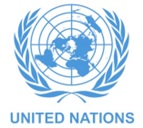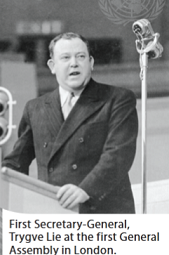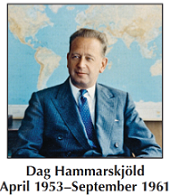| Selected text from the Bulletin of the Association of Former International Civil Servants, Vol. 54 ♦ no. 1 ♦ summer 2025 – page 12, where readers may find many more photos and additional information. |

All you need to know outlined in questions and answers
Question 1: When the UN was founded in 1945, how many nations did it represent, and which three of these were not independent States?
Answer 1: The UN was founded in 1945. It was originally formed by 51 countries. While 50 countries initially signed the Charter at the United Nations Conference in San Francisco on 26 June, 1945, Poland signed it later on 15 October 1945, making the total 51. India (1947), the Byelorussian Soviet Socialist Republic (1991), and the Ukrainian SSR (1991) were not yet independent states when they signed the Charter.
Question 2: How did India become a founding member of the UN when it was still a British colony?
Answer 2: India was a “self-governing state” since the Paris Peace Conference in 1919 and a member of the League of Nations, which the conference founded in 1920, and thus also a member of its successor agencies the International Labour Organization (ILO) and the Permanent Court of International Justice (the PCIJ), etc. India was also a signatory to the Declaration by United Nations [wartime coalition of Allied powers] of 1942, which states that “self-governing states, colonies that enjoy the full power of self-governance can be admitted”. Reportedly, while Britain gave India a voice at international consortia in return for stopping the freedom struggle, India used its voice to get international support for freedom instead. India’s delegation announced its intention to represent itself rather than the British Empire, and started to refer to itself as a “self-governing State”. Citing inter alia its important role during World War II, India argued that the world could not function
peacefully without its military and economic support. This helps explain how India was added as a founding member. (Source documents: Everyman’s United Nations 1948, Eighth (latest) Edition; Everyone’s United Nations 1986).
Question 3: When is UN Charter Day? Where was it first celebrated? 
Answer 3: The Charter was signed on 24 June 1945 in San Francisco (UN Charter Day). Here is a link to the SG’s statement on this year’s Charter Day; and a link to a related UN Chronicle article.
Question 4: When is UN Day and what does it signify?
Answer 4: UN Day is 24 October. The Charter came into force on 24 October 1945, and the anniversary of its entrance into force is celebrated as UN Day. (The General Assembly Resolution 168 declaring UN Day is dated 31 October 1947).” (https://docs.un.org/en/A/RES/168%20(II))
Question 5: Can you guess any of the seven Precursor Declarations and Conferences to the Charter?
Answer 5: The seven Precursor Declarations and Conferences to the Charter were: The Inter-Allied Declaration (London) in 1941; The Atlantic Charter (Churchill/Roosevelt at sea) in 1941 [photos sourced by Dawne Gautier]; The Declaration by United Nations; The Moscow and Teheran Conferences in 1943 (in which the USSR, the UK, the US and China participated); The Dumbarton Oaks Conference in 1944 (in Georgetown, Washington DC) and The Yalta Conference in 1945 (on the South coast of the Crimean peninsula—then part of Ukraine—on the Black Sea).
Question 6: How many female delegates attended the San Francisco Conference?
Answer 6: There were eight female delegates, including Ellen Wilkinson from the United Kingdom; Florence Gertrude Horsbrugh from the United Kingdom; Mary McLeod Bethune from the United States; Dr. Bertha Lutz from Brazil and women delegates from Australia and Uruguay. The four female signatories of the Charter came from Brazil, China, the Dominican Republic and the US. During the first session of the General Assembly, Eleanor Roosevelt called a meeting of women delegates to address an Open Letter to the Women of the World. E Wilkinson (United Kingdom) addressed the meeting.
Question 7: When were the first four African States admitted? Which were they?
Answer 7: Egypt, Ethiopia, Liberia and South Africa joined in 1945. The next 20 years saw the majority of African states join upon achieving independence.
Question 8: Where did the first General Assembly meet?
Answer 8: In London’s Westminster Hall in February 1946.
Question 9: Who were the Mohicans?
Answer 9: Staff who joined the UN before or at its inception, on or before 15 August 1946, prior to the move to Lake Success. Some served from then through to retirement, such as Sir Brian Urquhart and Jean Gazarian.
Question 10: Who laid the cornerstone of the United Nations Headquarters at Turtle Bay? When? And with what documents?
Answer 10: Trygve Lie, the Norwegian first Secretary-General, laid the cornerstone in October 1949, along with a copy of the Charter and the Universal Declaration of Human Rights [UN Chronicle 75th Anniversary of the Charter].
Question 11: Bearing in mind that English and French are considered working languages of the UN, when did the General Assembly adopt Modern Standard Arabic as its sixth official language?
Answer 11: On 18 December 1973, which is now UN Arabic Language Day. Jean Gazarian joined in 1946 as a translator and rose to Director of the Division of General Assembly Affairs; Gazarian devoted his life to international public service. Even after retirement in the late 1980s, he served a nearly 20-year stint teaching diplomats and staff as a full-time Senior Fellow at UNITAR. He was a most kind, devoted, cultured and knowledgeable man, and for a long time one of the backbones of the Association Culturelle Francophone, which showed French films.
Question 12: When did the Department of Public Information institute the six language days and what is
their significance?
Answer 12: Language days were designated in 2010 for symbolic (poets’ birthdays) or historic reasons.
Question 13: What other languages have had days attributed to them since?
Answer 13: In 2019, UNESCO declared World Portuguese Day on 5 May and in 2022, Swahili Language Day on 7 July.
Question 14: In which of the six principal organs of the UN are the official languages only English and French?
Answer 14: The International Court of Justice (ICJ), which is in The Hague, Netherlands.
Question 15: When did the General Assembly establish the Committee on the Status of Women?
Answer 15: 1946. In order to advance women’s rights, the UN organized four world conferences on women: Mexico City (1975), Copenhagen (1980), Nairobi (1985), and Beijing (1995).
Question 16: When did the GA establish the Scientific Committee on the Effects of Radiation?
Answer 16: On 3 December 1955, ten years after the bombings of Hiroshima (6 August 1945) and Nagasaki (9 August 1945). In 1987, one year after the Chernobyl incident (12 April 1986), the General Assembly concluded that “a considerable increase in the incidence of thyroid cancer due to radiation exposure should be expected, particularly among those exposed as children…”
Question 17: When was the first conference focused on solar energy held?
Answer 17: The United Nations Conference on New Sources of Energy (solar, geothermal and wind power) was held in Rome in 1961.
Question 18: When was the International Convention on the Elimination of All Forms of Racial Discrimination adopted by the GA?
Answer 18: In 1965, the Committee on the Elimination of Racial Discrimination (CERD) was established to review periodic reports on members’ adherence to the Convention.
Question 19: Can you name the 4 major UN Conferences on the Environment?
Answer 19: The 1972 Stockholm Conference; The 1982 Earth Summit in Nairobi; The 1992 UNCED Rio Conference or Earth Summit; The 2002 World Summit on Sustainable Development, also known as the Earth Summit 2002 or Rio+10, in Johannesburg, South Africa.
Question 20: When and where was the first UN Conference on the Law of the Sea held?
Answer 20: 1958 in Geneva, which adopted the four Conventions on the Law of the Sea. The next one was also in Geneva in 1960. The UN Convention on the Law of the Sea (UNCLOS) was ratified by 168 parties drawn up by the third UN Conference on the Law of the Sea between 1973 and 1982.
Question 21: When and at which conference were the Beijing Declaration and Platform of Action adopted?
Answer 21: The 1995 Fourth World Conference on Women (FWCW), Beijing, which led to the adoption of the Beijing Declaration and Platform for Action. One of the most comprehensive global agendas, it set strategic objectives promoting women’s rights and gender equality.
Question 22: Which two women attended the Beijing Conference and went on to become elected Heads of State?
Answer 22: H.E. Ellen Johnson Sirleaf attended the conference in her capacity as Head of the UNDP Regional Bureau for Africa, and became Africa’s first elected female President of Liberia (2006-2018). H.E. Netumbo Nandi-Ndaitwah attended the conference as Rapporteur General of the FWCW and Chief Negotiator for the African Group, and became Africa’s second female elected President of Namibia (December 2024).
Question 23: How often was the Nobel Peace Prize awarded to the United Nations?
Answer 23: The Nobel Peace Prize was awarded to the UN 12 times, including to the UN itself, various specialized agencies, funds, programmes, related organizations, and individual staff members. It was awarded twice to the Office of the High Commissioner for Refugees (1954 and 1981). In 1988, the Prize was awarded to the UN peacekeepers, and in 2001 to both the United Nations and its Secretary-General Kofi Annan “for their work for a better organized and more peaceful world”.
Question 24: Which award is on display at UN Headquarters?
Answer 24: Kofi Annan’s. (It appears to be on loan as Nane Annan donated it to the Palais des Nations in Geneva on 19 February 2024.)
Question 25: Which is the only Council Chamber no longer used for its original function? When did this stop, and why? Where is it?
Answer 25: The Trusteeship Council suspended its operations on 1 November 1994, a month after the independence of Palau, the last remaining UN trust territory. It is the closest of the three Council Chambers to the Delegates’ Lounge and is decorated by Denmark with a large angel on the left side of the front of the room. It is currently being used to discuss a variety of subject matters, especially the environment (management of the global commons).
Question 26: What was the first budget of the UN?
Answer 26: The total 1946 UN budget was $19,390,000 as compared with $3.72 billion for 2025.
Question 27: How many Specialized Agencies are there?
Answer 27: There are 17 Specialized Agencies, including three that make up the World Bank Group: the International Bank for Reconstruction and Development (IBRD), the International Finance Corporation (IFC), and the International Development Association (IDA). In addition to the Specialized Agencies, the UN comprises many funds and programmes, including The United Nations Children’s Fund (UNICEF), founded in 1946 to provide emergency relief for children victimized by World War II, a Fund; and the United Nations Development Programme (UNDP) a Programme supporting countries to end poverty and protect the planet.
Question 28: Who suggested the IAEA?
Answer 28: The President of the United States, Dwight D. Eisenhower, in December 1953 suggested the establishment of a world organization devoted exclusively to the peaceful uses of atomic energy.
Question 29: How many NGOs currently have consultative status with ECOSOC?
Answer 29: At the end of December 2024, there were 6,468 non-governmental organizations, while the number of quadrennial reports they produce has risen to 1,215.
Question 30: In 2020, how many Member States elections did the UN support?
Answer 30: The UN supported 50 elections that year.
Question 31: Can you name the nine Secretaries-General in the order in which they served?
Answer 31: From 1946 to 2025:
Trygve Lie 
February 1946–April 1953
Dag Hammarskjöld
April 1953–September 1961
U Thant
November 1961–December 1971
Kurt Waldheim
January 1972–December 1981
Javier Pérez de Cuéllar
January 1982–December 1991
Boutros Boutros-Ghali
January 1992–December 1996
Kofi Annan
January 1997–December 2006
Ban Ki-moon
January 2007–December 2016
António Guterres
January 2017–to the present
Comments powered by CComment